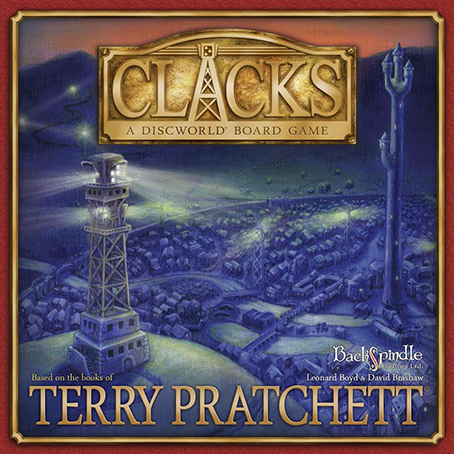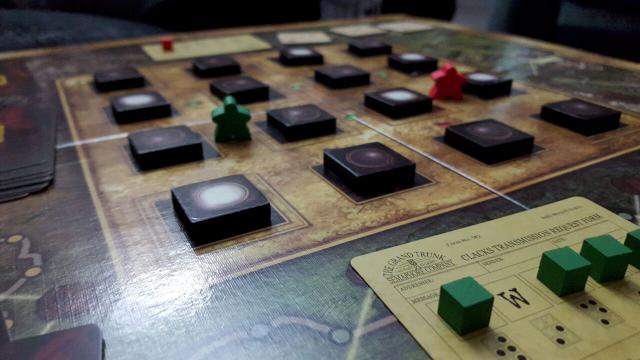
“Oh my god, you need to use your brain…” – never try to teach someone to play Clacks when they’ve already had a bottle of wine to themselves. Clacks is, after all, a tricky puzzle game where you’ll be turning lamps on and off in specific patterns in order to produce various combinations of lights and spell out a word. Spotting patterns can be tough going, cards can be rotated at will and the letters themselves can be formed in several areas of the board, making for a game which demands your full attention and focus whether playing it as a competitive or co-op game.
But let’s just rewind a bit and see how this works. Whether playing as a co-op or competitive game the concept is the same – you need to be forming a series of letters to spell words and transmit them across the land. It’s all based around a Discworld novel where the Clacks system is set up to help transmit messages instead of using the Post Office, or something to that effect. Not having read any Terry Pratchett books I’m not familiar with the Discworld bit and bobs, but it’s not entirely necessary anyway – the key is how the Clacks system works, and how you’ll be using it.

In the competitive game each player has a card with a 5 letter word on it. Each letter, as you can see in the above photo, has a different patterns of lights associated with it – the word here was DWARF; the green blocks show that 4 of the 5 letters have already been created, and just the W remains – you can see the required light pattern to form each character. Each player also has three Jacquards, basically small square cards which have a set pattern of lights on. When these are played any lights on the board which match the Jacquard’s layout are reversed, hopefully forming the right pattern for your intended letter. It’s a tricky thing to explain without the game in front of you, but when it’s all together it’s surprising how quickly it slots into place and makes sense (unless that aforementioned bottle of wine has been demolished, obviously). Tying all of this together is the stress system, set up to prevent you from putting too much stress on the lamps by limiting what you can do in each turn. Before forming a letter on the board your little meeple guy needs to be in the right place, which costs stress points, and each Jacquard has a stress cost too. It’s a good dynamic in the game which forces you to priorities your strategies a little.
Also helping or hindering you along the way are the fault cards, which let you carry out certain effects on you, your opponents or the board as a whole. Such effects include only allowing a player to use a single Jacquard on their turn, or turning the entire board of lights on or off. They can turn a potentially game-winning move into a total mess, which is great when you mess up someone else’s turn, but heart-breaking if it happens to you. And that’s one of the fun things about Clacks – you get almost just as much luck out of screwing things up for others as you do from aiming to form your own letters. Some won’t like the game being so harsh and cut-throat as that, but it’s the nature of the competitive game and personally I really enjoyed the annoyance I caused other players from time to time.
For a friendlier approach though, the co-op option is great. Expanding the playing area out to the board around the outside as well as the middle, this is a straight up race between your Clacks system and the Post Office who are trying to send a message across the land the fastest. The message you need to broadcast (using the same methods as before) is two words long, and includes a space and end character to bring the total to 12 letters. To make life tougher though they need to be sent in the correct order from left to right, so you’ll need to work together and plan ahead, which leads to a very very different kind of game to the competitive side of things. In the co-op, each stress point used advances the Post Office marker along the road, and depending on whether you select the easier or harder option that’ll only need 34 or 38 spaces for them to deliver the message. A tall order! You do have the option of swapping your Jacqards for a couple of reserves nearby, but these also spark off Operator Logs or Incident Reports, which tend to have a negative impact on your attempts, so it’s a risk/reward decision to make. I actually had a couple of games on my own using this game mode, and while it misses the idea of working together with someone else, it was a very passable and enjoyable experience, giving you a solo version of the game with very few changes needed.
The one complaint though I’d have about Clacks (which, as you can probably tell I enjoyed a lot) was the components. The cards are nice, there’s a cool felt bag to put the Jacquards in, and the wooden tiles feel great when you’re handling them, but they don’t come pre-stickered. That’s not a problem by itself, but the stickers are almost exactly the same size as the tiles, making them a massive git to get on accurately. There are a few spare stickers, but some more thought could have been made to the sizing, and the fact it took me nearly an hour to unpack and prepare the game wasn’t idea when we wanted to try it out straight away! If you’ve got this, get it read before you plan on giving it a go, you won’t regret it!
So Clacks is a very entertaining game which despite having been around for a fair while is still a relevant and fun experience. There’s no need to have a prior knowledge of Discworld to play (although you might enjoy the theme more if you do) and the options of working together or against each other is a very welcome mix of play styles. If you don’t like fierce competition in your games then you’ll want to give it a miss as the competitive elements require some pretty unfriendly tactics at times, but generally for an abstract puzzle type game which you can pick up and play pretty quickly then it comes very much recommended.

Leave a Reply